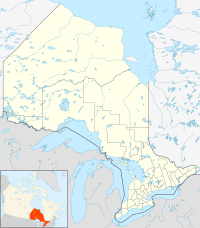Chapleau 74A facts for kids
Quick facts for kids
Chapleau 74A
|
|
|---|---|
| Chapleau Indian Reserve No. 74A | |
| Country | |
| Province | |
| District | Sudbury |
| First Nation | Chapleau Ojibway |
| Area | |
| • Land | 7.63 km2 (2.95 sq mi) |
| Population
(2011)
|
|
| • Total | 31 |
| • Density | 4.1/km2 (11/sq mi) |
| Website | chapleauojibwe.ca |
Chapleau 74A is a special area of land in Canada known as a First Nations reserve. It is located in the province of Ontario, not far from the town of Chapleau, Ontario. This reserve is one of the lands belonging to the Chapleau Ojibway First Nation.
Contents
What is a First Nations Reserve?
A First Nations reserve is a piece of land set aside by the Canadian government for the use and benefit of a specific First Nation group. These lands are important for preserving the culture, traditions, and way of life of Indigenous peoples. They are often where members of the First Nation live and gather.
Chapleau 74A: A Closer Look
Chapleau 74A is a smaller reserve. In 2011, about 31 people lived there. The land area of the reserve is about 7.63 square kilometers. This makes it a quiet place, surrounded by nature in the Sudbury District of Ontario.
Who are the Chapleau Ojibway First Nation?
The Chapleau Ojibway First Nation is an Indigenous community. They are part of the larger Ojibwe (also known as Anishinaabe) people, who have lived in this region for thousands of years. Their culture is rich with history, language, and traditions. The Chapleau Ojibway First Nation has several reserves, and Chapleau 74A is one of them.
Location and Geography
Chapleau 74A is located in a beautiful part of Ontario. It is found at coordinates 47°48′N 83°23′W. This area is known for its forests, lakes, and rivers, which are important for traditional activities like hunting, fishing, and trapping. The natural environment plays a big role in the lives of the people who live there.
Connecting with the Community
The Chapleau Ojibway First Nation has a website, chapleauojibwe.ca, where you can learn more about their community, history, and current activities. Websites like this help share information and connect people with the First Nation's story.


